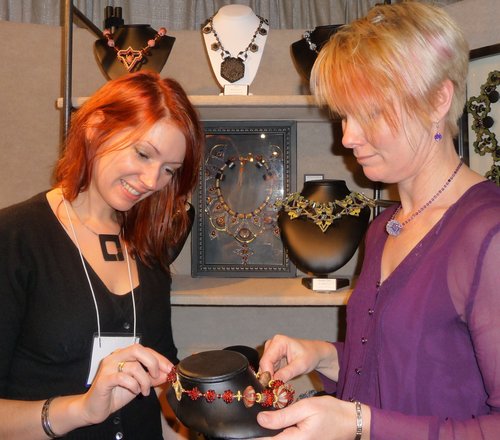by Carolyn Edlund
Will being an authority or expert in what you do sell your art? Not by itself. Your customers buy pretty much what they like and value.

Jewelry artist Kathy King (right) shows a technique that she developed to a customer.
But art buyers also like to feel that they are buying from a professional, who is recognized at being really good at what they do. Establishing authority will make most potential customers take you more seriously, and it will build credibility. Share this on your website, in your marketing efforts and even in conversations when appropriate.
What gives the impression of credibility?
- Being a teacher or speaker in your field of art
- Long term experience as an artist
- Having written a book on the field of your expertise
- Your educational background and training
- That you have invented a process or a technique that is all your own
- Your website has a highly professional presentation
- That you are a leader in professional associations
- A long history of exhibitions
- A list of your work that is included in corporate or museum collections
- You have been interviewed by the press
- Your materials include testimonials from satisfied collectors
- Articles that you have written on topics in your expertise
- A large social media following
- Ability to speak confidently about your work, technique and inspiration
- That your work is related to a cause, especially when you are a leader in that cause
- A background where you have acted as a curator, an advisor, a jury member or board member
On the other hand, you can undermine yourself, even inadvertently, which may lead potential customers to become confused, or wonder if you are serious.
Mistakes include:
- Hesitancy to call yourself an artist
- Lack of preparation when speaking about yourself in front of customers
- A blog that is abandoned, making it look like you may even be out of business
- Incomplete or bare bones website
- Poorly taken images of your work
- Inconsistency in your body of work
- Inconsistent social media presence
Most every artist falls somewhere between these two extremes. What evidence of authority do you have in your favor? Make a list of plusses that you can use in your own marketing materials and in-person presentation that will help you gain credibility.




This is absolutely true. Great article!
Thanks, Renee. I should add to the list “being featured on Manhattan Arts” !
Carolyn, how about adding “being featured on the Artsy Shark website”?
I’m going to list your article as a “Must Read” in the next Manhattan Arts Members Email Newsletter in addition to posting it in social media. I was in the middle of writing something similar when I saw your article so thank you for doing the work for me!
It all basically boils down to how badly an artist wants to succeed. It is really nice to see a ‘list’ or a GPS (to me) of what it takes to become a successful and respected artist. It made me chuckle when I was reading it — having a keen background in Greek Classics, it reminded me of the ’12 Labors of Hercules’, ‘Jason’s Labor of The Golden Fleece’ as well as ‘the Labors of Perseus’ all put together in one. Of course if an artist is motivated, dedicated with singularity of purpose the success is not only possible but probable indeed.
Brilliant collection of important points from Carolyn as usual! You so rock.
And I so totally agree that expertise equals sales. Confidence is a two way street. If you are confident in your abilities and demonstrate that to the public, the public becomes more confident in the VALUE they gain with purchasing your work.
However, I must point out that there is a fine line when doing “in-person” sales: One should avoid doing too much show and tell or being a curator of technical or historical information. A beautiful display of one’s art coupled with a simple portfolio opened to your CV can often have much more impact than explaining what a aquatint is and pulling out a copper plate and droning on about the “how”.
Artists who are insecure about the value (price) of their oeuvre will often confuse explaining technique (the specialized education, specialized tools used, and time spent) with creating desirability or “authority” and see that as creating the value and making the price more acceptable. It’s much more subtle in reality.
Avoid falling into the trap of trying to build up value to justify price. If someone is falling in love with your art form, it’s time for romance, not scholarly lectures. If they really want to know how you create your art beyond the obvious, they will ask! But even then – keep it simple.
And, oh, BTW, if you seem defensive or are appearing to defend your price (“The lady doth protest too much, methinks” – thanks Shakespeare!) be very careful how you established value with your “time expenditure”. I just heard an artist say, “it takes many, many days – sometimes weeks – to complete each of these”, however, his prices were all under $250 and he had many dozens on display. Opps! Quick math makes his prices look very cheap and his sales very slow.
Concentrating on selling the “value of ownership” with creating desire of a wonderful long-term relationship with fine artistry will always make more sales than focusing on selling the value of “time/materials” and “woe is me – I work really hard” stories.
thank you for that helpful information very helpful!!!